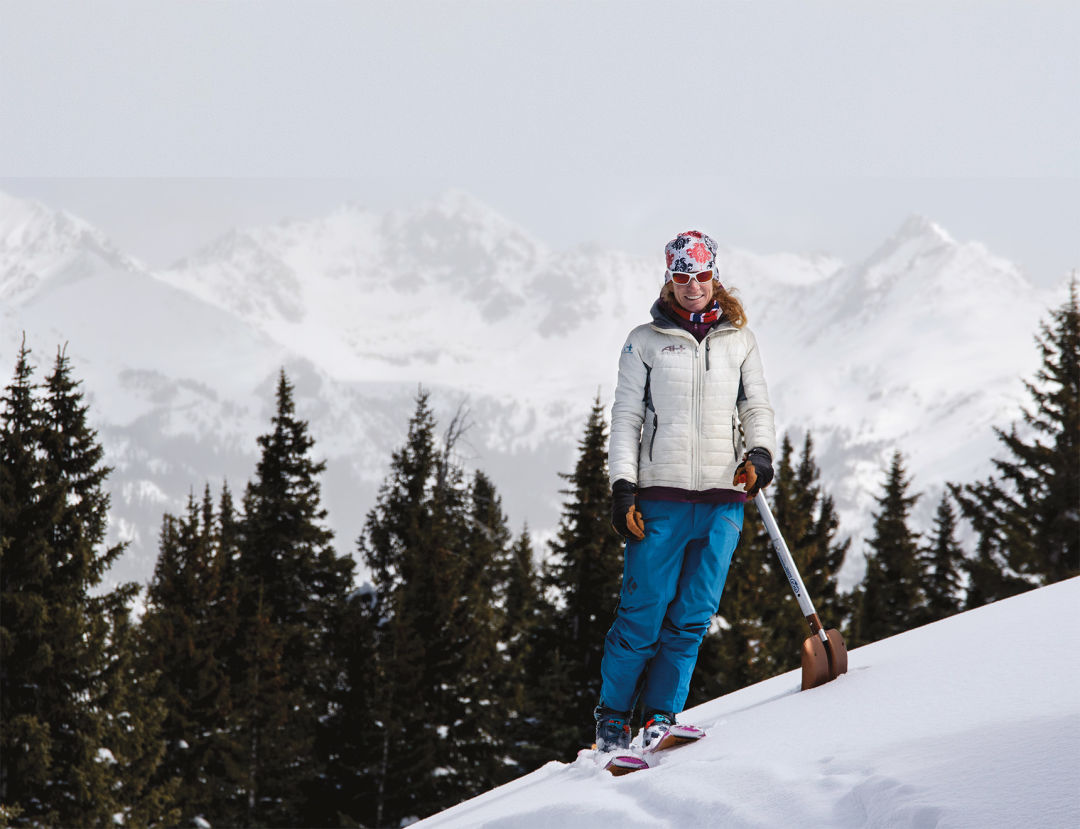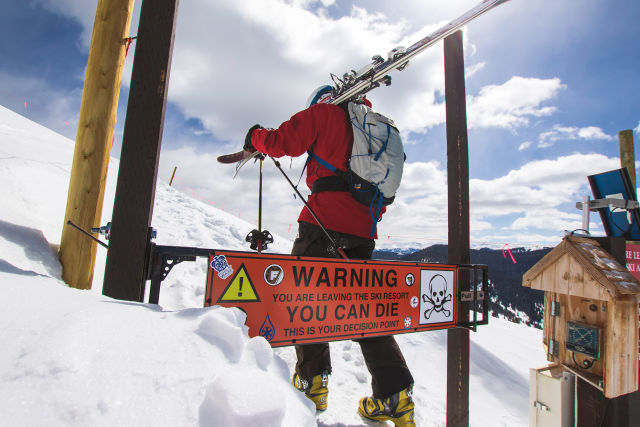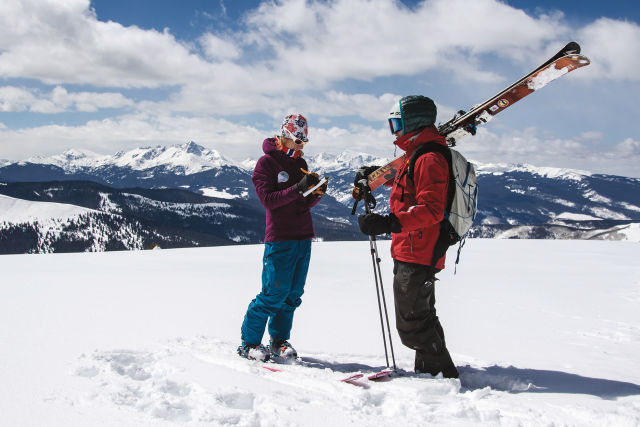Surveying Risk Takers in East Vail's Avalanche Zone

Avalanche safety educator Kelli Rohrig at the top of Benchmark above the East Vail Chutes.
Image: Liam Doran
Kelli Rohrig is standing on an alpine ridge above the expansive East Vail backcountry ski zone, waiting for someone—anyone—to show up. It’s a gray, windy morning with a bite to the air. Not ideal for conducting interpersonal research, but Rohrig has a rare day off from teaching avalanche safety courses, so she figures it is worth spending a couple of hours in the stinging maw to find a few willing survey subjects.
She is here to ask any skiers and snowboarders she observes heading into the zone to locate a buried avalanche transceiver—and see if they can do it in two minutes or less, a common standard for rescue scenarios. Their success or failure will inform a multi-year user study of one of America’s deadliest backcountry zones—responsible for eight avalanche deaths since 1986.
The popularity of East Vail has increased greatly since the late 1980s, when new lifts to the top of China and Mongolia Bowls afforded anyone with a ski pass easy access to the out-of-bounds chutes and bowls of East Vail. No longer did it take an hour and a half of commitment to reach the ridge on which Rohrig stands. Now, resort guests of any skill level can simply walk through an exit gate on the northeastern boundary of Vail Mountain, shoulder their skis, and trudge 10 minutes up a staircase-like bootpack, likely without breaking a sweat. But the backcountry terrain that beckons from below when they reach the top is substantially more complex and far more deadly than the patrolled and avalanche-controlled terrain they left behind in the resort, whether they realize it or not.

Explicit signage warns resort skiers of the dangers and risks of unpatrolled and uncontrolled terrain outside resort boundaries, especially in the avalanche-prone East Vail Chutes.
Image: Liam Doran
Four years ago, Rohrig, who is 50 and has lived in Vail for most of her life, started surveying skiers and snowboarders at the East Vail bus stop, offering chocolate bars to those willing to answer her questions. She had noticed a significant uptick in East Vail users, as well as a more competitive atmosphere among them, and wondered who was driving the growth. “Previously, I feel like we were … I don’t want to say a tight-knit group, but quite often you knew everybody who was out here, and it was a friendly community,” she says. Then the numbers began to boom, from 20 to 30 users per day to upwards of 200 now. “It seemed a little more dog-eat-dog. I wanted to know why that was.”
Rohrig surveyed 95 users in her first round of research and recorded alarming results. One in two had triggered an avalanche; one in four had been caught. Only about 10 percent had practiced with their beacons in the preceding year. As an avalanche educator, the data stunned her. As a longtime East Vail skier, it upset her. It also led her to start testing people’s rescue skills last winter.
Rohrig started skiing East Vail with friends in 1987, fresh out of high school, where she’d been an all-state ski racer. Only a handful of regulars made the pilgrimage back then, among them future freeskiing stars Seth Morrison and Shane McConkey, whom she knew personally. Her father, a former Crested Butte ski patroller, had been one of the first in Eagle County to sell avalanche transceivers at his Avon gear shop, the Golden Beaver. But Rohrig, like most users, never carried rescue gear when she started skiing East Vail, and no one seemed concerned. “We had no clue that it was dangerous,” she says. “No idea at all.”
She left Vail to travel and intern at the European Parliament in Belgium, but the mountains and skiing pulled her back. When she was 24, she jumped a cliff on Vail Pass and triggered a slide that buried her up to her neck. Neither she nor her partners had rescue gear. The experience sobered them—but didn’t scare them away. “We started recognizing, OK, snow is not just white, and it’s not always safe,” she says. “It moves sometimes.”
After more wandering, Rohrig landed in Big Sky, Montana, where she coached the junior freeride team. Kids were required to carry avalanche gear during training sessions, even inbounds. “They were 10 years old and knew how to use a transceiver, and they were good at it,” Rohrig says. “Being around that stuff created a small addiction in me.” She started teaching avalanche safety courses and moved back to Vail in 2010, where the work continued. Now, Rohrig leads 20 to 25 full courses per winter for clients including Paragon Guides and Colorado Mountain College in Edwards. She also gives about 15 free avalanche presentations at ski shops and in classrooms.
Perhaps the most notable of Rohrig’s snow-safety work resulted from a collaboration with her older brother, longtime pro skier and Warren Miller film star Chris Anthony. The siblings launched the Glide Project four years ago to provide subsidized avalanche education to local high school students. It has since expanded to Aspen, Steamboat Springs, and Summit County. “We’ve taught about 50 kids an official Level 1 class, and hundreds more through presentations,” Rohrig says, laughing about how different she and her brother remain despite their overlapping professions. “I like my hidden life in the mountains. He’s so much more of a people person. It’s only with the Glide Project that we’ve really come together and started learning from each other.”
Rohrig lives in Eagle-Vail with her husband, Kreston, an avalanche forecaster she met in an EMT class. Despite skiing almost every day, they don’t need powder to be happy. “We will ski absolute crap and be totally psyched,” she says. “Somebody else might be like, ‘I’m never coming with you again.’ But: We turn! What’s the problem? If there’s white on the ground ... it’s a good day.”
At the root of her research and teaching is a desire for backcountry skiers and snowboarders to look after each other and stay safe in the changing environment that she reveres. Every time a test subject fails to locate a beacon she’s buried at the top of East Vail, she cringes. She wants everyone to succeed. The stakes are high here, and the zone is only getting to be more popular—like others around the country. It’s one reason why Rohrig is publishing her results for the first time this winter in The Avalanche Review, a well-read periodical for snow-safety pros.

Rohrig surveys a skier about his readiness for the avalanche terrain of the East Vail Chutes; most East Vail skiers are woefully unprepared, and unequipped, for the dangers of they will encounter.
Image: Liam Doran
Her biggest takeaways? “That perception is not reality,” she says. “And I can say that from my own experience. Because I was right there with ’em, dropping in and thinking I knew when I didn’t. And I still don’t know. It’s still a guessing game.”
She is here to ask any skiers and snowboarders she observes heading into the zone to locate a buried avalanche transceiver—and see if they can do it in two minutes or less, a common standard for rescue scenarios. Their success or failure will inform a multi-year user study of one of America’s deadliest backcountry zones—responsible for eight avalanche deaths since 1986.
The popularity of East Vail has increased greatly since the late 1980s, when new lifts to the top of China and Mongolia Bowls afforded anyone with a ski pass easy access to the out-of-bounds chutes and bowls of East Vail. No longer did it take an hour and a half of commitment to reach the ridge on which Rohrig stands. Now, resort guests of any skill level can simply walk through an exit gate on the northeastern boundary of Vail Mountain, shoulder their skis, and trudge 10 minutes up a staircase-like bootpack, likely without breaking a sweat. But the backcountry terrain that beckons from below when they reach the top is substantially more complex and far more deadly than the patrolled and avalanche-controlled terrain they left behind in the resort, whether they realize it or not.
Four years ago, Rohrig, who is 50 and has lived in Vail for most of her life, started surveying skiers and snowboarders at the East Vail bus stop, offering chocolate bars to those willing to answer her questions. She had noticed a significant uptick in East Vail users, as well as a more competitive atmosphere among them, and wondered who was driving the growth. “Previously, I feel like we were … I don’t want to say a tight-knit group, but quite often you knew everybody who was out here, and it was a friendly community,” she says. Then the numbers began to boom, from 20 to 30 users per day to upwards of 200 now. “It seemed a little more dog-eat-dog. I wanted to know why that was.”
Rohrig surveyed 95 users in her first round of research and recorded alarming results. One in two had triggered an avalanche; one in four had been caught. Only about 10 percent had practiced with their beacons in the preceding year. As an avalanche educator, the data stunned her. As a longtime East Vail skier, it upset her. It also led her to start testing people’s rescue skills last winter.
Rohrig started skiing East Vail with friends in 1987, fresh out of high school, where she’d been an all-state ski racer. Only a handful of regulars made the pilgrimage back then, among them future freeskiing stars Seth Morrison and Shane McConkey, whom she knew personally. Her father, a former Crested Butte ski patroller, had been one of the first in Eagle County to sell avalanche transceivers at his Avon gear shop, the Golden Beaver. But Rohrig, like most users, never carried rescue gear when she started skiing East Vail, and no one seemed concerned. “We had no clue that it was dangerous,” she says. “No idea at all.”
She left Vail to travel and intern at the European Parliament in Belgium, but the mountains and skiing pulled her back. When she was 24, she jumped a cliff on Vail Pass and triggered a slide that buried her up to her neck. Neither she nor her partners had rescue gear. The experience sobered them—but didn’t scare them away. “We started recognizing, OK, snow is not just white, and it’s not always safe,” she says. “It moves sometimes.”
After more wandering, Rohrig landed in Big Sky, Montana, where she coached the junior freeride team. Kids were required to carry avalanche gear during training sessions, even inbounds. “They were 10 years old and knew how to use a transceiver, and they were good at it,” Rohrig says. “Being around that stuff created a small addiction in me.” She started teaching avalanche safety courses and moved back to Vail in 2010, where the work continued. Now, Rohrig leads 20 to 25 full courses per winter for clients including Paragon Guides and Colorado Mountain College in Edwards. She also gives about 15 free avalanche presentations at ski shops and in classrooms.
Perhaps the most notable of Rohrig’s snow-safety work resulted from a collaboration with her older brother, longtime pro skier and Warren Miller film star Chris Anthony. The siblings launched the Glide Project four years ago to provide subsidized avalanche education to local high school students. It has since expanded to Aspen, Steamboat Springs, and Summit County. “We’ve taught about 50 kids an official Level 1 class, and hundreds more through presentations,” Rohrig says, laughing about how different she and her brother remain despite their overlapping professions. “I like my hidden life in the mountains. He’s so much more of a people person. It’s only with the Glide Project that we’ve really come together and started learning from each other.”
Rohrig lives in Eagle-Vail with her husband, Kreston, an avalanche forecaster she met in an EMT class. Despite skiing almost every day, they don’t need powder to be happy. “We will ski absolute crap and be totally psyched,” she says. “Somebody else might be like, ‘I’m never coming with you again.’ But: We turn! What’s the problem? If there’s white on the ground ... it’s a good day.”
At the root of her research and teaching is a desire for backcountry skiers and snowboarders to look after each other and stay safe in the changing environment that she reveres. Every time a test subject fails to locate a beacon she’s buried at the top of East Vail, she cringes. She wants everyone to succeed. The stakes are high here, and the zone is only getting to be more popular—like others around the country. It’s one reason why Rohrig is publishing her results for the first time this winter in The Avalanche Review, a well-read periodical for snow-safety pros.
Her biggest takeaways? “That perception is not reality,” she says. “And I can say that from my own experience. Because I was right there with ’em, dropping in and thinking I knew when I didn’t. And I still don’t know. It’s still a guessing game.”






































